#digital marketing trends
Text
How to Make Money Using Digital Marketing in 2024?
Introduction:
In today's fast-paced world, digital marketing has emerged as a game-changer, offering countless opportunities to individuals and businesses alike. With the ever-growing online landscape, 2024 holds incredible potential for those looking to harness the power of digital marketing to generate income and create a promising future. In this blog post, we'll explore how you can make money using digital marketing in 2024 and how Seven Boats Academy can help you embark on this exciting journey.
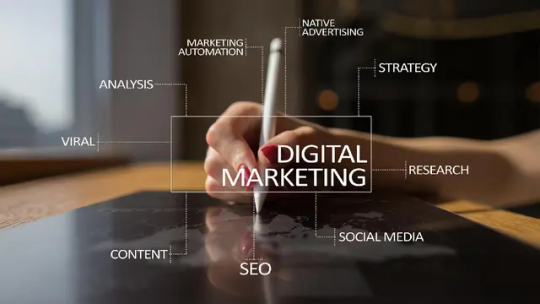
The Digital Marketing Landscape in 2024:
As we step into 2024, the digital marketing landscape is more dynamic and expansive than ever before. Here are some key trends and opportunities to keep in mind:
E-commerce Boom: The growth of online shopping continues to skyrocket. Learn how to optimize e-commerce websites, create compelling product listings, and use digital marketing techniques to drive sales for businesses.
Content Reigns Supreme: High-quality, engaging content is the cornerstone of digital marketing. Master content creation, SEO, and content marketing to attract and retain an online audience.
Social Media Dominance: Social media platforms remain central to digital marketing strategies. Discover the art of social media advertising, influencer collaborations, and community building to reach a global audience.
Data-Driven Decision Making: Data analytics and insights drive successful digital campaigns. Learn how to interpret data, make informed decisions, and optimize your marketing efforts for maximum returns.
Mobile Marketing: As mobile device usage continues to grow, understanding mobile marketing strategies is crucial. Ensure your digital marketing efforts are mobile-friendly and accessible.
How to Make Money Using Digital Marketing in 2024:
Now, let's delve into some actionable steps to start making money through digital marketing in 2024:
Education and Training: To succeed in the digital marketing landscape, it's essential to acquire the right skills and knowledge. Consider enrolling in courses like those offered at Seven Boats Academy. Their comprehensive programs cover various aspects of digital marketing and provide you with the expertise you need to excel.
Specialize: Digital marketing encompasses various niches, including SEO, content marketing, social media, and more. Identify your passion and strengths, then specialize in a specific area to stand out in the industry.
Build an Online Presence: Establish a strong online presence through your website and social media profiles. This not only showcases your skills but also serves as a portfolio for potential clients or employers.
Networking: Connect with professionals in the digital marketing field through networking events, social media, and industry forums. Building a network can open up opportunities for collaboration and career growth.
Freelancing and Consulting: Many businesses are looking to outsource their digital marketing needs. Consider freelancing or offering consulting services to help businesses grow their online presence.
Start Your Own Digital Marketing Agency: If you're ambitious and experienced, consider starting your own digital marketing agency. This allows you to take on clients and build a sustainable income stream.
Conclusion:
The world of digital marketing is full of opportunities waiting to be seized in 2024 and beyond. Whether you're looking to make extra income, launch a new career, or start your own agency, the key is to invest in education, specialize in your area of interest, and continuously adapt to the evolving digital landscape.
Ready to embark on your journey towards financial success through digital marketing in 2024? Look no further! Seven Boats Academy, recognized as the top digital marketing institute in India, offers an array of cutting-edge courses that will equip you with the skills and knowledge needed to thrive in the digital marketing landscape. Whether you're a beginner looking to kickstart your career or a seasoned professional aiming to stay ahead of the game, Seven Boats Academy has tailored programs designed just for you. Don't miss out on this golden opportunity to learn from industry experts and be part of a vibrant community of digital marketing enthusiasts. Take the first step towards a brighter future by checking out Seven Boats Academy today!
#digital marketing#digital marketing trends#marketing digital#marketing online#marketing#marketing strategy
9 notes
·
View notes
Text
How to Stay Updated on the Latest Digital Marketing Trends
Introduction:
In the ever-evolving landscape of digital advertising, staying up-to-date is not only useful; it is essential for achievement. With the era advancing unexpectedly, consumer behavior shifting, and new platforms emerging, digital marketers usually have to adapt their strategies. We'll discover powerful methods for staying up-to-date on today's digital advertising trends and leveraging them to improve your digital marketing offering.
Subscribe to Industry Newsletters:
Sign up for newsletters from legitimate websites and digital marketing systems.
Receive curated updates on enterprise trends, new equipment and emerging techniques instantly to your inbox.
Engage in Social Media Communities:
Join applicable digital advertising companies on structures like LinkedIn, Facebook, and Twitter. Participate in discussions, share insights, and examine from the reviews of other professionals inside the area.
Attend Webinars and Virtual Events:
Stay up to date on upcoming webinars and digital activities inside the virtual advertising and marketing area.
Attend sessions hosted by industry professionals to benefit insights into rising tendencies and high-quality practices.
Enroll in Online Courses and Certifications:
Invest in continuous gaining knowledge of through on-line publications and certifications. Platforms like Coursera, LinkedIn Learning, and Google Digital Garage offer publications on the modern digital marketing traits and techniques.
Listen to Podcasts: Podcasts are a handy manner to stay informed at the same time as on the cross. Subscribe to digital advertising podcasts that feature interviews with industry leaders and discussions on present day traits.
Set up Google Alerts:
Use Google Alerts to obtain email notifications about unique key phrases related to digital advertising and marketing developments.
Stay informed in real time about contemporary news, articles and discussions that can be used for your entertainment.
Network at Industry Conferences:
Attend industry meetings and networking activities.
Connect with professionals, attend workshops, and gain firsthand insights into the modern technology and tendencies shaping the virtual advertising panorama.
Experiment with Emerging Technologies:
Stay hands-on with experiments with growing technologies that include augmented reality, voice search and artificial intelligence.
Understanding how the technology draws will give you an aggressive edge in applying modern techniques.
Regularly Update Your Skill Set:
Digital advertising and marketing is a dynamic field; often replace your skill set.
Take gain of on-line assets, workshops, and education classes to keep your capabilities sharp and applicable.
Conclusion:
In the fast-paced global virtual advertising, keeping up with contemporary developments is a never-ending adventure. By applying a combination of lively learning, networking and staying in touch with enterprise experts, you can function yourself and your digital advertising and marketing services to thrive in the ever-changing digital panorama. Embrace curiosity, adaptability and constant schooling to live ahead of the curve and deliver exceptional results to your clients.
#best digital marketing company#digital marketing company in india#Latest Digital Marketing Trends#Digital Marketing Trends#digital marketing services#seo services#social media marketing services#best digital marketing company in pune#digital marketing company#best social media marketing company in pune
2 notes
·
View notes
Text
Getting Around in the World of Digital Marketing: A Comprehensive Guide
Introduction:
In today's rapidly evolving digital landscape, businesses are increasingly turning to digital marketing strategies to connect with their audience, drive growth, and stay ahead of the competition. This comprehensive guide provides an in-depth exploration of digital marketing, covering its various uses, strategies, and best practices.
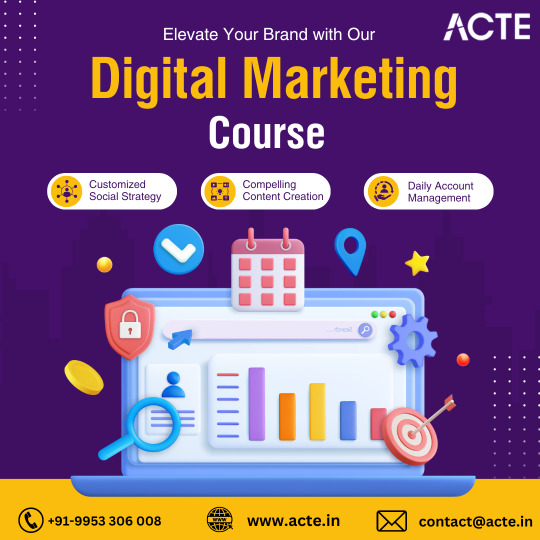
Understanding Digital Marketing:
Digital marketing encompasses a broad range of online strategies and tactics aimed at promoting products, services, and brands through digital channels. From search engine optimization (SEO) and social media marketing to email campaigns and content marketing, digital marketing offers businesses diverse avenues to engage with their target audience and achieve their marketing objectives.
Exploring the Uses of Digital Marketing:
Enhanced Brand Visibility: Digital marketing helps businesses boost their online presence and visibility, ensuring that their brand remains prominent and memorable among consumers in a crowded digital space.
Driving Website Traffic: By optimizing their websites for search engines and utilizing paid advertising channels, businesses can attract qualified traffic to their sites, increasing the chances of conversions and sales.
Lead Generation and Conversion: Digital marketing tactics such as email marketing, social media advertising, and content marketing are instrumental in capturing leads and nurturing them through the sales funnel, ultimately driving conversions and revenue.
Building Customer Relationships: Digital marketing allows businesses to engage with their audience on a more personal level, fostering relationships and loyalty through targeted communication and customized messaging.
Measuring Performance: One of the key advantages of digital marketing is the ability to track and measure campaign performance in real-time, enabling businesses to refine their strategies and optimize their marketing efforts for better results.
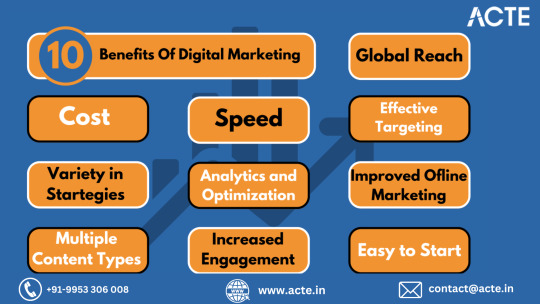
Deciphering the Mechanics of Digital Marketing:
Digital marketing operates on the principle of leveraging digital channels and technologies to connect with target audiences, deliver tailored messages, and prompt desired actions. Here's a breakdown of how it works:
Objective Identification: Businesses start by defining their marketing objectives and identifying their target audience, including demographics, interests, and preferences.
Strategic Planning: Based on their objectives and audience insights, businesses develop a comprehensive digital marketing strategy that outlines the tactics and channels they will use to achieve their goals.
Content Creation: Content is the cornerstone of digital marketing. Businesses create engaging and relevant content, such as blog posts, social media updates, videos, and infographics, to resonate with their audience and drive action.
Channel Deployment: Businesses deploy a mix of digital channels, including websites, social media platforms, email, search engines, and online advertising networks, to distribute their content and reach their target audience effectively.
Lead Engagement: Through targeted messaging and personalized communication, businesses engage with their audience, nurture leads, and guide them through the sales funnel towards conversion.
Performance Analysis: Digital marketers continuously monitor and analyze campaign performance metrics, such as website traffic, conversion rates, click-through rates, and engagement metrics. Based on these insights, they refine their strategies and optimize their campaigns for better results.
Conclusion:
Digital marketing has emerged as a fundamental component of modern business strategy, offering unparalleled opportunities for growth and engagement in an increasingly digital world. By understanding the various uses, strategies, and mechanics of digital marketing, businesses can harness its power to drive success and stay ahead of the curve in today's competitive marketplace.
#digital marketing#tech#technology#digital marketing training#digital marketing course#digital marketing trends#digital marketing company#education#search engine marketing#seo
2 notes
·
View notes
Text
Disruptive Innovation Keynote Speaker Jeremy Gutsche on Trends & Change
" Top Innovation Keynote Speaker Jeremy Gutsche's speech on trends, change, creativity and disruptive innovation. In this disruptive innovation keynote speech, Jeremy (...) walks though how disruptive innovation happens, how to create a culture of innovation & change and the Trend Hunter's top 18 futurist mega trends impacting our world. "Disrupt or be Disrupted" is his latest and best speech on disruptive innovation and creativity and was presented at Trend Hunter's epic Future Festival Trends Innovation Conference (where it was titled "How to Spark a Revolution")
As a New York Times Bestseller, CEO of Trend Hunter and one of the top innovation keynote speakers, Jeremy has helped 500 brands, billionaires to implement disruptive innovation strategies in order to avoid being disrupted themselves. The Disruptive Innovation Keynote Speech is structured in five parts, based off several of Jeremy's latest keynote speaker topics:
i. INTRO - MOTIVATIONAL SPEECH ON INNOVATION - Ignite your enthusiasm for change with Jeremy's high energy keynote speaker style as he introduces the reason for studying disruptive innovation and trends.
ii. KEYNOTE SPEECH ON CHANGE & DISRUPTION - Learn why disruptive innovation happens, and the need for companies to adapt their business models sooner in Jeremy's thesis. This part of his innovation speech is based on research from his New York Times Bestseller "BETTER and FASTER" which is currently the top innovation keynote video on youtube with 6,000,000 views.
iii. KEYNOTE SPEECH ON PURPOSE - Learn how to create a culture of innovation with a 3-part culture framework from Jeremy's innovation speech on culture. This part is a bit more tactical, but to disrupt, innovate or make change happen, you need a culture of innovation and change.
iv. KEYNOTE SPEECH ON TRENDS & TREND-BASED INNOVATION - Modeled off Trend Hunter's big data from 130,000,000 people, this part of the disruptive innovation keynote speech gets deeper into the futurist mega trends that are shaping our world, and how your business can adapt to leverage trends. Disruptive innovation starts with creative ideas that are linked to the trends that are changing business.
v. KEYNOTE SPEECH ABOUT INNOVATION AND ACTION - Finally, Jeremy wraps up with a couple examples from his strategy keynote about action and how innovation often stems from little ideas that you can make big. People think about disruption as something linked to big Eureka moments, but actually disruptive innovation is more frequently linked to little iterations, change, and adaptation that can be more broadly implemented into a company's business strategy and organizational culture.
"Disrupt or be Disrupted" is a TED Talks style speech on innovation is designed to inspire you, and if you want more, but if you want more, come to Future Festival where you can spend more time exploring the top 18 Disruption Megatrends AND take part in Trend Hunter's innovation workshops to identify disruptive innovation opportunities for your own brand. "
Source: Trend Hunter - 2017
#mktmarketing4you#corporatestrategy#marketing#M4Y#lovemarketing#IPAM#ipammarketingschool#ContingencyPlanning#virtual#volunteering#project#Management#Economy#ConsumptionBehavior#BrandManagement#ProductManagement#Logistics#Lifecycle
#Brand#Neuromarketing#McKinseyMatrix#Viralmarketing#Facebook#Marketingmetrics#icebergmodel#EdgarScheinsCultureModel#GuerrillaMarketing#STARMethod#7SFramework#gapanalysis #AIDAModel #SixLeadershipStyles #MintoPyramidPrinciple #StrategyDiamond #InternalRateofReturn #irr #BrandManagement #dripmodel #HoshinPlanning #XMatrix #backtobasics #BalancedScorecard #Product #ProductManagement #Logistics #Branding #freemium #businessmodel #business #4P #3C #BCG #SWOT #TOWS #EisenhowerMatrix #Study #marketingresearch #marketer #marketing manager #Painpoints #Pestel #ValueChain # VRIO #marketingmix
youtube
5 notes
·
View notes
Text
What is The Future of Digital Marketing Trends in 2024
Quickbloging discuss about topic In 2024, digital marketers are facing a new reality with stricter privacy regulations and the decline of third-party cookies. Future of Digital Marketing Trends in 2024 today is complex and it's inevitable it will get more complex in the future as new technologies and platforms emerge.
#digital marketers are facing a new reality with stricter privacy regulations and the decline of third-party cookies. Future of Digital Marke#fb#digital marketing#SEO#Digital marketing trends
2 notes
·
View notes
Text
how can succesd in freelancing
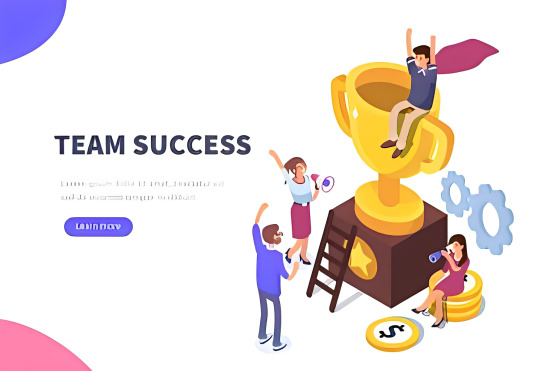
Success in freelancing requires a combination of skills, strategies, and a proactive approach. Here are some tips to help you succeed in freelancing:
Identify Your Niche: Determine what skills you excel at and what services you can offer. Specializing in a niche can help you stand out and attract clients looking for specific expertise.
Build a Strong Portfolio: Create a portfolio showcasing your best work. This can be a website or a profile on freelancing platforms. Potential clients often want to see examples of your previous work to assess your skills and style.
Set Clear Goals: Define your short-term and long-term goals. Understand what you want to achieve with freelancing, whether it's financial independence, skill development, or building a full-time business.
Create a Professional Profile: Your profile is often the first impression clients have of you. Make sure it's complete, highlights your skills and experience, and includes a professional photo.
Choose the Right Platforms: There are various freelancing platforms like Upwork, Freelancer, Fiverr, and others. Choose platforms that align with your skills and goals. Research each platform's policies, fees, and competition before deciding.
Set Competitive Rates: Research the market rates for your services and set your prices competitively. Consider your skill level, experience, and the value you provide to clients.
Effective Communication: Respond promptly to inquiries, be clear in your communication, and manage client expectations. Good communication is crucial for building trust and lasting relationships.
Deliver High-Quality Work: Consistently provide quality work to build a positive reputation. Satisfied clients are more likely to give you repeat business and positive reviews.
Manage Your Time: Freelancers often juggle multiple projects. Effective time management is essential to meet deadlines and maintain a healthy work-life balance.
Networking: Network with other freelancers and potential clients. Attend relevant events, join online forums, and use social media to connect with people in your industry.
Continuous Learning: Stay updated on industry trends and continuously improve your skills. Learning new technologies or staying current with industry best practices can make you more valuable to clients.
Legal and Financial Considerations: Understand the legal and financial aspects of freelancing, including taxes, contracts, and invoicing. Consider consulting with a professional to ensure you're compliant with regulations in your area.
Build Client Relationships: Cultivate positive relationships with your clients. A satisfied client is more likely to provide referrals and come back for future projects.
Remember that success in freelancing often takes time. Be patient, stay persistent, and adapt your strategies based on your experiences. Learning from both successes and setbacks will contribute to your growth as a freelancer.
2 notes
·
View notes
Text
How to Boost Your Online Presence with Digital Marketing
Discover effective strategies to enhance your online presence through digital marketing. Boost visibility, attract customers, and drive growth. Learn more!
Introduction
According to recent reports, the digital advertising industry in India witnessed substantial growth, reaching a market size of nearly 300 billion Indian rupees in the year 2022. This represents a significant leap from the market size recorded in the year 2016 source: statista.com
In today's digital age, having a strong online presence is essential for businesses of all sizes. Digital marketing offers a wide range of strategies and techniques that can help boost your online visibility, attract more customers, and drive business growth. In this article, we will explore various ways to enhance your online presence through effective digital marketing strategies.
Table of Contents
Understanding the Importance of Online Presence
Developing a Comprehensive Digital Marketing Strategy
Building a User-Friendly Website
Implementing Search Engine Optimization (SEO)
Creating Engaging Content
Leveraging Social Media Platforms
Harnessing the Power of Email Marketing
Embracing Video Marketing
Engaging with Online Communities and Influencers
Utilizing Pay-Per-Click (PPC) Advertising
Analyzing and Measuring Performance
Keeping Up with Digital Marketing Trends
Incorporating Mobile Optimization
Enhancing Customer Experience through Personalization
Conclusion
1. Understanding the Importance of Online Presence
In the digital landscape, having a strong online presence is crucial for businesses to succeed. It allows you to reach a wider audience, increase brand awareness, and establish credibility in your industry. A robust online presence also enables you to connect and engage with potential customers, driving conversions and sales.
2. Developing a Comprehensive Digital Marketing Strategy
To boost your online presence effectively, it's essential to develop a comprehensive digital marketing strategy. Start by defining your goals and target audience. Conduct thorough market research to identify the platforms and channels your target audience frequents. Then, create a roadmap that outlines the specific tactics and techniques you will employ to achieve your objectives.
3. Building a User-Friendly Website
A well-designed and user-friendly website is the foundation of your online presence. Ensure that your website is visually appealing, easy to navigate, and mobile responsive. Optimize it for fast loading speeds and ensure that the content is relevant, informative, and engaging.
4. Implementing Search Engine Optimization (SEO)
SEO plays a vital role in improving your online visibility and driving organic traffic to your website. Conduct keyword research to identify relevant keywords and incorporate them naturally into your website's content. Optimize your meta tags, headings, and alt tags with relevant keywords to enhance your website's search engine rankings.
5. Creating Engaging Content
Content is king in the digital world. Create high-quality, engaging, and informative content that resonates with your target audience. Publish blog posts, articles, videos, and infographics that provide value and address your audience's pain points. Incorporate relevant keywords to improve search engine rankings and share your content across various platforms to maximize its reach.
6. Leveraging Social Media Platforms
Social media platforms offer immense opportunities to boost your online presence. Identify the platforms that align with your target audience and develop a strong presence on them. Regularly share engaging content, interact with your followers, and leverage social media advertising to reach a broader audience. Utilize analytics tools to measure the effectiveness of your social media efforts and make data-driven decisions.
7. Harnessing the Power of Email Marketing
Email marketing remains one of the most effective strategies for nurturing leads and driving conversions. Build an email list by offering valuable incentives such as exclusive content or discounts. Segment your email list based on customer preferences and behaviors to send personalized and targeted messages. Craft compelling subject lines and content to encourage email opens and click-throughs.
8. Embracing Video Marketing
Video marketing has gained significant popularity in recent years. Create engaging and informative videos that showcase your products or services, provide tutorials or demonstrations, or share customer success stories. Publish your videos on platforms like YouTube, Vimeo, and social media channels to increase your online visibility and engage with your audience on a deeper level.
9. Engaging with Online Communities and Influencers
Active participation in online communities and collaboration with influencers can greatly enhance your online presence. Identify relevant online communities and forums where your target audience interacts and contributes valuable insights and expertise. Build relationships with influencers in your industry who can endorse your brand and expose it to a larger audience.
10. Utilizing Pay-Per-Click (PPC) Advertising
PPC advertising allows you to display targeted ads to potential customers and drive traffic to your website. Conduct thorough keyword research and create compelling ad copy to optimize your PPC campaigns. Monitor and analyze your campaign's performance regularly, making necessary adjustments to maximize your return on investment (ROI).
11. Analyzing and Measuring Performance
To continually improve your online presence, it's crucial to analyze and measure the performance of your digital marketing efforts. Utilize tools like Google Analytics to track website traffic, user behavior, and conversion rates. Monitor key performance indicators (KPIs) such as click-through rates, bounce rates, and social media engagement. Use the insights gained to refine your strategies and optimize your online presence further.
12. Keeping Up with Digital Marketing Trends
The digital marketing landscape is ever-evolving, with new trends and technologies emerging regularly. Stay updated with the latest industry news and developments. Embrace new technologies, platforms, and strategies that can help you stay ahead of the competition and maintain a strong online presence.
13. Incorporating Mobile Optimization
In the mobile-driven era, optimizing your online presence for mobile devices is essential. Ensure that your website is mobile-friendly, with responsive design and fast loading speeds. Optimize your content for mobile consumption and leverage mobile advertising to reach users on the go.
14. Enhancing Customer Experience through Personalization
Personalization is key to delivering an exceptional customer experience and fostering loyalty. Leverage customer data and analytics to personalize your website content, email campaigns, and targeted ads. Tailor your messaging to address individual customer needs and preferences, making them feel valued and engaged.
15. Conclusion
Boosting your online presence through effective digital marketing strategies is a crucial step in today's competitive business landscape. By understanding the importance of online presence, developing a comprehensive digital marketing strategy, and implementing various techniques such as SEO, content creation, social media engagement, and video marketing, you can significantly enhance your brand's visibility and attract a larger audience. Stay proactive in analyzing performance, keeping up with trends, and embracing new technologies to maintain a strong and impactful online presence.
Q1: How long does it take to see results from digital marketing efforts?
A1: The time it takes to see results from digital marketing efforts can vary depending on various factors such as the strategies implemented, target audience, industry competition, and budget allocated. In some cases, you may start noticing improvements within a few weeks, while for others, it may take several months to see significant results. But if you want to accelerate your digital presence 8 Miles Solutions is here to help
Q2: Do I need to hire a digital marketing agency to boost my online presence?
A2: Hiring a digital marketing agency can provide you with expertise, resources, and a comprehensive strategy to enhance your online presence. And companies like 8 Miles Solutions are of great help
#boosting online presence#digital marketing#online visibility#attract customers#drive growth#digital advertising#market size#strong online presence#digital marketing strategy#user-friendly website#search engine optimization#engaging content#social media platforms#email marketing#video marketing#online communities#influencers#pay-per-click advertising#analyzing performance#digital marketing trends#mobile optimization#customer experience#personalization#digital marketing agency
6 notes
·
View notes
Text

Digital Marketing Tamil Memes
Best Digital Marketing Institute in Bangalore@NIDMINDIA
https://nidmindia.com/
3 notes
·
View notes
Link
Here are the 16 Key Insights from e-Commerce and Digital Marketing Trends for [2022-2025]. Learn tried and tested advice from key marketing leaders to stay ahead.
#Ecommerce#b2b ecommerce#digital marketing#business advertising#internet marketing#digital marketing trends#2023#2024#2025#ecom
3 notes
·
View notes
Link
Digital Marketing trends 2022
#digitalmarketingtrends2022#digital marketing trends#digitalmarketingservices#seo#seoservices#seoservice#digitalmarketingagency#digitalmarketingagency2022#socialmediamarketing#digitalmarkeitngtips#homedecore#property#digitalmarketingstrategy#business#housing#home#real estate#realestateagent#realato#realator#fashion#services#usa#canada#europe#india#china#china news
6 notes
·
View notes
Text

#cartoon#comics#digital painting#digital marketing#digital marketing consultant#digital marketing tips#online marketing#digital marketing trends
4 notes
·
View notes
Text
Google Ads to Promote Business
Google Ads is an online advertising platform developed by Google, where advertisers can bid on specific keywords or phrases to display their ads to a targeted audience.
Why use Google Ads?
Google Ads is the most popular online advertising platform, with over 3.5 billion searches per day. It offers advanced targeting options, real-time reporting, and a variety of ad formats to suit your business needs.
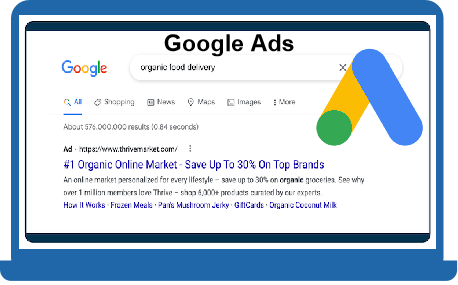
Benefits of using Google Ads:
Using Google Ads (formerly known as Google AdWords) offers several benefits for businesses looking to promote their products or services online. Here are some of the key advantages:
Targeted Advertising: Google Ads provides powerful targeting options that allow advertisers to reach specific audiences based on keywords, location, language, device type, demographics, and even user behavior. This level of precision enables businesses to tailor their ads to the right people at the right time, increasing the likelihood of attracting potential customers who are genuinely interested in their offerings. Targeted advertising helps improve conversion rates and reduces wasted ad spend on irrelevant audiences.
Measurable Results: One of the most significant advantages of Google Ads is the ability to track and measure the performance of your ads in real-time. Advertisers can access a wealth of data, including clicks, impressions, click-through rates (CTRs), conversions, and more. By analyzing these metrics, businesses can gain valuable insights into the effectiveness of their campaigns. This data-driven approach allows for continuous optimization, enabling advertisers to make data-backed decisions and improve the overall ROI of their advertising efforts.
Cost-effective Marketing: Google Ads operates on a pay-per-click (PPC) or pay-per-impression (CPM) model, which means advertisers only pay when someone clicks on their ad or when their ad is shown a certain number of times (in the case of CPM). This pay-as-you-go approach makes Google Ads a cost-effective marketing option, as advertisers have control over their budget and can set daily or monthly spending caps. Additionally, the targeting options help avoid spending on irrelevant audiences, making each ad dollar more efficient.
Increased Brand Awareness: Google is one of the most widely used search engines, with billions of searches conducted daily. By running ads on Google, businesses can expose their brand to a massive audience and increase brand visibility. Even if users don’t click on the ads immediately, they are still exposed to the brand name and message, which can lead to increased brand recall and consideration when the users are ready to make a purchase. Remarketing features also allow businesses to reconnect with users who have previously interacted with their website or app, reinforcing brand awareness and encouraging return visits.
Overall, Google Ads provides a versatile and results-driven advertising platform that empowers businesses of all sizes to reach their target audience effectively, track campaign performance accurately, manage ad spend efficiently, and enhance their brand’s presence in the digital landscape. When used strategically, Google Ads can be a powerful tool for driving traffic, generating leads, and boosting sales.
Types of Google Ads:
Google Ads offers various types of ad formats to advertisers, allowing them to target different audiences and achieve specific marketing goals. Here are the main types of Google Ads:
Search Ads: Search ads appear at the top or bottom of the Google search results page when users enter relevant keywords or phrases. These ads are text-based and typically consist of a headline, description lines, and a display URL. Advertisers bid on keywords, and when a user’s search query matches those keywords, their ad may appear. Search ads are great for reaching users actively looking for products or services, making them highly effective for generating leads and conversions.
For example, below are the search campaign ads for the keyword “laptops”. They appear on the search result page with the black “Ad” symbol next to the URL.
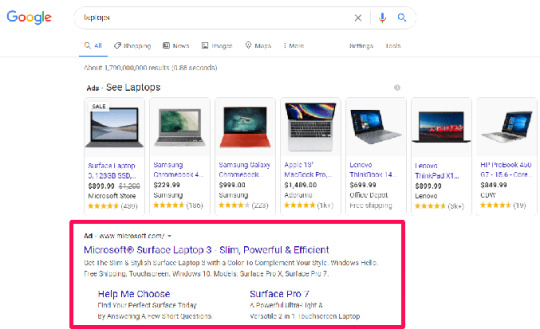
2. Display Ads: Display ads are visual advertisements that appear on websites within the Google Display Network (GDN). The GDN includes millions of websites and reaches a vast audience across various interests and demographics. Display ads can be in the form of banners, images, interactive ads, or even video. They are ideal for building brand awareness, reaching a broad audience, and showcasing products or services to potential customers.
The Display Network leverages Google’s vast website partners to showcase your ad on different websites all over the Internet. These ads appear on third-party websites like so:

3. Shopping Ads: Shopping ads (formerly known as Product Listing Ads or PLAs) are product-centric advertisements that appear on Google search results and Google Shopping. These ads display product images, prices, and other essential details directly in the search results. Shopping ads are particularly beneficial for e-commerce businesses as they allow users to see product information before clicking on the ad, leading to more qualified leads and higher conversion rates.
A shopping campaign allows you to promote your products in a much more visual way. These ads can appear as images on the search results page:
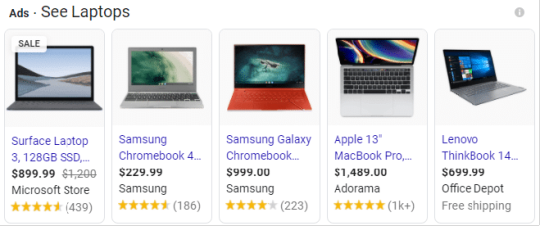
4. Video Ads: Video ads are advertisements that appear on YouTube and other Google partner sites. These ads can be in various formats, such as skippable in-stream ads, non-skippable in-stream ads, video discovery ads, and bumper ads.
Video ads are an effective way to engage users visually and deliver impactful brand messages. They are suitable for storytelling, product demonstrations, and increasing brand visibility through video content.

5. App Ads: App ads, also known as Universal App Campaigns (UAC), are designed to promote mobile apps across Google’s ecosystem, including Google Search, Google Play Store, YouTube, and the Display Network.
Advertisers can specify their app’s destination and ad text, and Google’s algorithm optimizes the campaign to reach users who are most likely to install the app. App ads are excellent for driving app downloads and increasing the user base for mobile applications.

Each type of Google ad has its unique advantages, and advertisers can choose the most appropriate ad formats based on their marketing objectives and target audience. The combination of different ad types allows businesses to create comprehensive and effective advertising strategies across various platforms and reach potential customers at different stages of the customer journey.
Conclusion:
In conclusion, Google Ads is a powerful tool that can help businesses of all sizes reach their target audience and achieve their marketing goals.
By utilizing its targeting capabilities, cost-effective pricing model, and detailed analytics, businesses can create effective campaigns and see measurable results.
Check out - The Ultimate Guide to Google Ads to get deep understanding of the topic.
Hope you enjoyed reading. 😄
Thanks!
About Me:
Hi! I’m Amisha Jaiswal. I’m a creative and passionate Digital Marketer. I strive to bring innovative ideas to life while making a meaningful impact.
Let’s connect — www.linkedin.com/in/amisha-jaiswal
#marketing#marketing trends#marketing digital#marketing strategy#marketing online#digital marketing#google ads#google adwords#google advertising#business#google algorithm#digital marketing tips#digital marketing trends
7 notes
·
View notes
Photo

Top four Digital Marketing Trends to look out for in 2023
Introduction
As technology continues to evolve, so too do the trends in digital marketing. It's important for businesses to keep up with these changes in order to stay competitive and continue to reach their target audiences. Here are the top 4 digital marketing trends as per the research by Top Digital Marketing Company to watch for in 2023.
1. Voice Search Optimization -
With the rise of voice assistants such as Amazon's Alexa and Google Home, optimizing your website for voice search is becoming increasingly important. By incorporating long-tail keywords and conversational language into your content, you can improve your chances of appearing in voice search results.
2. Personalization -
Consumers are looking for personalized experiences in their interactions with businesses. By leveraging data and technology, you can tailor your messaging and marketing strategies to individual customers. This can lead to increased customer loyalty and better engagement.
3. Video Marketing -
Video content continues to dominate social media and other online platforms. By creating engaging and informative video content, you can capture the attention of your target audience and drive more traffic to your website.
4. Augmented Reality -
Augmented reality technology is becoming more accessible, and businesses are starting to use it to enhance the customer experience. By incorporating AR into your marketing strategies, you can provide immersive and interactive experiences that can drive engagement and sales.
Conclusion
As these trends continue to grow in importance, it's essential for businesses to partner with the Best Digital Marketing Company that can help them stay ahead of the competition. With a focus on SEO, content marketing, and other digital marketing strategies, these companies can help you navigate the rapidly evolving landscape of digital marketing and take advantage of the latest trends. By staying up to date with the latest digital marketing trends and working with an experienced digital marketing agency, your business can continue to grow and succeed in the years to come.
#Best Digital Marketing Company#Digital Marketing Company In India#Digital Marketing Services#Top Digital Marketing Company#Digital Marketing Trends#Digital Marketing Trends in 2023
4 notes
·
View notes
Text
Navigating the Digital Marketing Landscape: A Self-Learning Journey
In the contemporary era, digital marketing has become a cornerstone of modern business strategies, shaping the way brands engage with their audience and drive growth in the digital realm. Learning digital marketing autonomously has emerged as a viable option for individuals seeking to acquire essential skills and stay abreast of industry trends.

In this guide, we'll delve into the intricacies of self-learning digital marketing and provide actionable steps to help you embark on your journey towards mastering this dynamic field.
1. Clarify Your Learning Goals:
Before delving into the vast expanse of digital marketing, it's imperative to establish clear learning objectives. Whether you aim to elevate your career, establish a successful online presence, or cultivate a new skill set out of personal curiosity, defining your goals will serve as a guiding light throughout your learning expedition.
2. Harness Online Learning Resources:
The internet is replete with an array of educational resources tailored to suit the needs of aspiring digital marketers. Platforms such as HubSpot Academy, Google Digital Garage, and Moz offer an assortment of free courses covering diverse facets of digital marketing, ranging from SEO and social media marketing to content creation and email campaigns. Embrace these resources to build a solid foundation of knowledge and expertise.
3. Enroll in Structured Online Courses:
Structured online courses provide a systematic approach to learning digital marketing, offering curated content delivered by industry experts. Platforms like Coursera, Udemy, LinkedIn Learning, and Skillshare offer a plethora of courses replete with video lectures, interactive exercises, and certification options to validate your proficiency in the subject matter.
4. Engage with Industry Thought Leaders:
Stay abreast of the latest trends and developments in digital marketing by immersing yourself in industry blogs, publications, and forums. Websites like Search Engine Journal, Neil Patel, and Social Media Examiner serve as invaluable repositories of insights and best practices shared by seasoned professionals. Actively participate in discussions, subscribe to newsletters, and seek mentorship to enrich your learning journey.

5. Translate Knowledge into Action:
Theory without practice is akin to a ship without a sail. Translate your theoretical understanding of digital marketing into tangible outcomes by undertaking hands-on projects. Whether it's launching a website, crafting social media campaigns, or experimenting with email marketing strategies, practical application is paramount in honing your skills and gaining valuable experience.
6. Leverage Free Tools and Resources:
Harness the power of free digital marketing tools and resources available at your disposal. Platforms like Google Analytics, Facebook Ads Manager, and Canva offer complimentary versions or trial periods for beginners to explore and familiarize themselves with essential tools of the trade. Experimentation with these tools will deepen your understanding and proficiency in digital marketing practices.
7. Cultivate a Network of Like-Minded Individuals:
Forge meaningful connections with fellow digital marketers through online communities, networking events, and professional associations. Collaborate on projects, seek mentorship, and engage in knowledge-sharing endeavors to broaden your perspectives and accelerate your growth within the digital marketing sphere.
8. Embrace Lifelong Learning:
In the ever-evolving landscape of digital marketing, adaptability is key to success. Stay abreast of emerging trends, algorithm updates, and technological advancements by continuously seeking opportunities for learning and growth. Embrace a mindset of lifelong learning, and remain open to new ideas and methodologies to stay ahead of the curve.
Conclusion:
Embarking on a self-learning journey in digital marketing is a rewarding endeavor that empowers individuals to unlock their potential and thrive in the digital era. By leveraging online resources, enrolling in courses, engaging with industry thought leaders, and applying practical knowledge, you can chart a course towards becoming a proficient digital marketer. With dedication, perseverance, and a thirst for knowledge, you can navigate the complexities of the digital marketing landscape with confidence and competence.
#digital marketing#tech#technology#digital marketing course#digital marketing training#digital marketing trends#digital marketing company#education#search engine marketing#seo
2 notes
·
View notes
Text
What is a divisional structure?
A divisional structure in an organization is a type of organizational structure where the company is divided into distinct divisions or business units, each responsible for its own set of products, services, or geographic regions. Each division operates as a separate entity with its own functional departments, such as marketing, finance, and operations. The idea is to organize the company based on its outputs or markets served rather than its functions.
Key characteristics of a divisional structure include:
Autonomy: Each division operates independently and has its own set of decision-making authorities. This allows divisions to respond more quickly to changes in their specific markets or industries.
Specialization: Divisions are often organized around specific products, services, or geographic regions. This specialization enables each division to focus on the unique needs and challenges of its market.
Accountability: Divisions are accountable for their own performance. This can lead to a clearer line of responsibility and performance evaluation, as each division is responsible for its own results.
Flexibility: The divisional structure is often more flexible and responsive to changes in the external environment. Each division can adapt its strategies and operations to suit its specific market conditions.
Coordination: While each division operates independently, there is still a need for coordination at the corporate level to ensure that overall organizational goals are met. Centralized functions may exist to oversee common activities such as finance, human resources, and strategic planning.
Customer Focus: With a divisional structure, the organization can be more customer-focused. Divisions can tailor their products and services to the specific needs of their target customers.
Divisional structures are commonly found in large and diversified organizations that operate in multiple industries or markets. This structure allows the organization to allocate resources efficiently and respond effectively to diverse market demands. However, it can also lead to duplication of efforts and coordination challenges between divisions. The success of a divisional structure depends on effective communication, coordination, and a balance between central control and divisional autonomy.
But what is the best model?
There isn't a one-size-fits-all answer to the question of the "best" divisional structure for an organization, as the most appropriate structure depends on various factors including the organization's size, industry, goals, and external environment. However, I can highlight a few common types of divisional structures and their potential benefits:
Product-Based Divisional Structure:
Advantages: This structure is effective when the organization offers a diverse range of products or services. Each division is responsible for a specific product or product line, allowing for specialization and focused expertise.
Example: A consumer goods company might have divisions for different product categories like electronics, household goods, and personal care.
Geographic-Based Divisional Structure:
Advantages: Suitable for organizations with operations in different geographic locations. Each division is responsible for a specific region, which allows for better adaptation to local market conditions and regulations.
Example: An international company might have divisions for North America, Europe, Asia-Pacific, etc.
Customer-Based Divisional Structure:
Advantages: Effective when an organization serves different types of customers or markets. Divisions are organized around customer segments, ensuring a customer-centric approach to business.
Example: A financial institution might have divisions for retail banking, corporate banking, and wealth management.
Matrix Divisional Structure:
Advantages: Combines elements of both functional and divisional structures. Employees report to both functional managers and divisional managers, providing a balance between specialization and coordination.
Example: A project-based organization might have functional departments (e.g., marketing, finance) and project teams that cut across these functions.
Hybrid Divisional Structure:
Advantages: Integrates various divisional structures to meet the organization's specific needs. For example, a company might have a combination of product-based and geographic-based divisions.
Example: An automobile manufacturer might have divisions based on vehicle types (cars, trucks) and regions (North America, Europe).
The choice of the best divisional structure depends on the organization's strategic goals, the nature of its products or services, the diversity of its markets, and its internal capabilities. It's crucial for an organization to regularly assess its structure and be willing to adapt it as needed to remain agile and responsive to changes in the business environment. Additionally, effective communication and coordination mechanisms must be in place to ensure the success of any divisional structure.
As an example for your question, I suggest visit this page https://www.wallstreetmojo.com/divisional-structure/ and after, complement the information, watching this video with examples https://youtu.be/xuGh-jzupzc?si=zhrt4l5pbM_fT9jU . Then you can also visit this playlist https://www.youtube.com/playlist?list=PLvtNS5N2VoAsLWmSlLVSPgyIlgqTwDGEd related to the subject you are looking for.
Stay cool and study
#marketing#marketing4you#estratégia#branding#advertising#digital marketing trends#mobile strategy#social media#youtube
3 notes
·
View notes